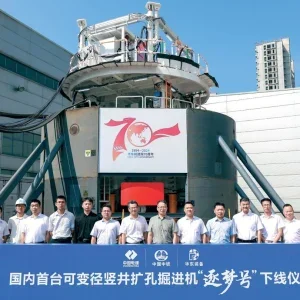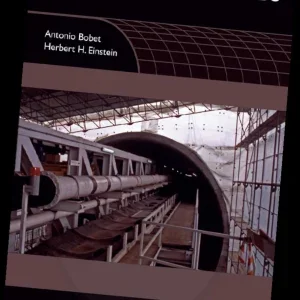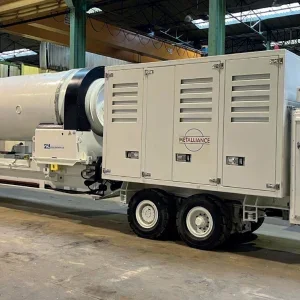The long-awaited turning point in construction of running tunnels came about in 2010, when Metrostav purchased two Herrenknecht TBMs for the metro V.A extension. The machines are EPB type, production numbers S-609 (Tonda) and S-610 (Adéla). The names were given to the machines by children from Motol Hospital. From 2011 the TBMs bored more than 4km of running tunnels from the Vypich construction site to the existing metro station Dejvická. The shields are 6m in diameter and the segmental lining is 5.3m/5.8m in diameter, with the ring configuration 1.5m wide in a 5+1 configuration. Rings are universal, with horizontal and vertical tunnel alignment controlled by turning the tapered ring.
The two-component grouting behind the lining is performed continuously with boring. The transport of segments and other materials is by multipurpose service vehicle (MSV), each with an 18t capacity, and belt conveyors were used for muck removal. TBM assembly and launch took place at the Vypich site, and logistics were later switched to the E2 site (the construction site in the vicinity of Cervený vrch housing estate and Evropská Street) only after TBM Tonda reached Cervený vrch station, or ended just before this station (in the case of Adéla). Afterwards all operations were transferred to the E2 site with an open construction pit in close proximity to the Evropská trída.
During their journey, the EPBMs were pulled through the following stations: Petriny, Veleslavín (including a short, open pit in front of the station) and Cervený vrch, as well as through the construction pit on the E2 site. Before reaching the existing station Dejvická, where they were dismantled, they had to pass through a short tunnel mined perpendicularly to the alignment, which will _ rst serve for removal of dismantled TBM parts and later technology equipment will be put there. The launch of machines at the Vypich site, and in the E2 open pit, was accomplished with the help of heavy launch frames supplied by Herrenknecht. For the restart operation in all stations another way had to be found due to the limited space in tunnels.
At the ends of stations, starter tunnels were mined and in them steel collars anchored to the primary shotcrete lining. After moving the shield inside, steel braces were welded to the collar and these gave support to the shield thrust cylinders during the restart operation. During the negotiation with Herrenknecht, and for factory and site acceptances, Metrostav employed John Foster, the prominent TBM expert from the UK. EPBM boring was successful, and the required skills for assembly and operation were mastered rather quickly. During the assembly, and later during operation, a number of specialists from Herrenknecht and its sub-companies H+E and VMT were present on the site. Many other companies supplied material and technical help, including BASF, Mapei and Condat.
Segment production was by Doprastav Bratislava at their segment factory in Senec, with nine sets of stationary moulds supplied by Herrenknecht Formwork. The production was done without heating, and a daily production rate of nine rings. The segments were _ tted with neoprene gaskets from Phoenix company. In the right running tunnel from the E2 site to the Cervený vrch station, 10 rings with steel fibre reinforcement were installed, also produced in Senec.
There was no experience with modern TBM technologies, and the last experience with TBM mining was in the 1970s. Moreover, even in terms of modern TBM technologies some of the latest advancements were applied, which are not always seen elsewhere. These were namely belt conveyors, two-component grouting and railless transport. Belt conveyor transport is being seen more and more for continuous excavation, and besides the financial advantages, worldwide usage was also an argument for preferring it to rail transport.
The belts began operation at the Vypich site, where all the drives, transfers station and storage towers were, before transferring them to the E2 site. Together with the conveyor belt supplier, H+E Logistic, a series of challenges were solved, for example the transfer of muck from two conveyor belts to one in the twin truck NATM tunnel, the length of belt when using just one drive from Vypich beyond the E2 site, or the steep inclination of belts on the same site.
Two-component grouting, as the term suggests, is mixed from two components, A and B. Component A is a mix of cement (300kg), bentonite (35kg), water (800 litres) and plasticiser (8kg). The volumes in brackets are valid for one cubic metre of the mix. Component A is mixed on the surface and is transported to the tank on the TBM by pipes. To allow pumping the mix has to stay stable for 72 hours. From the tank on the TBM the mix is pumped via pipes integrated directly in the tail skin into the space behind the assembled ring. Component B, ‘water glass’ is added with a volume of seven per cent and mixed with component A in the mixing box, which is 1.2m from the end of tailskin. After adding component B an approximately 20 seconds wait sees the mix take on a gel consistency, which prevents its washing out in the case of underground water inflow. At the start of boring there were often breaks and interruptions and it was obvious that the system, against all declared advantages over the more conservative method with cement mortar, will require regular maintenance. This is valid mainly for the last section of pipes from the mixing box to the end of tailskin. Significant improvements were patented improvement (P. Hybský and J. Kafka, both from Metrostav), where in the mixing box the silicon hose was attached to the component B outlet and therefore the mixing and gelling happened at the end of the tail skin.
Both machines were equipped with ‘CBP-Tunnel construction information system’, which was supplied together with other systems by VMT. The system continuously collects and evaluates all the available data and transfers them in the form of messages and reports on the displays, either directly on the TBM or in the of_ ces of authorised staff.
Both TBMs completed their boring on 26 November 2012 with a double breakthrough.
STATIONS, AND PULLING TBMS THROUGH THEM
On Line V.A there are three mined stations. Petriny (constructed by Metrostav) and Cervený vrch (by Hochtief) are single vault stations, while station Veleslavín (by Subterra) is a three vault station, built by NATM with reinforced concrete lining.
Single vault stations are similar to Kobylisy Station on metro line IV.C, the difference is the added complication by both TBMs being pulled through partially excavated stations. In the case of Petriny Station, after completing side drifts, the construction of the station was partially interrupted and temporary structures to pulling the TBMs were built. In this case these were reinforced concrete cradles with cast in rails serving to move the shield, the backup moved on the temporary invert from concrete segments laid on the sand layer. Temporary concrete structures were later demolished as the station construction progressed. The notable feature of Petriny Station was the fact that due to the existence of an access tunnel located between the running tunnels, the middle part of the station could be excavated even during the period when both side drifts served for TBM logistics work (i.e., ventilation, piping, transport).
The total excavated profile of the station is 265m 2, and the width of the excavation was 22m with a height of 15.5m. Twothirds of the excavated profile was in a waterbearing sandstone layer, the lower third was in claystone. To prevent the negative impact of the station body on the underground water flow, the system of drainage outside the primary lining was put into operation, allowing water flow under the station. The final lining is cast in-situ reinforced concrete with intermediate waterproofing, sprayed waterproofing has been applied on both station face walls.
Through the construction pit in front of the mined Veleslavin station and through both side tunnels with primary lining, based on experience with previous pulling of the shields, these were pulled through using prefabricated steel structures, which enabled repetitive usage for pulling through the open pit at E2 and through the station Cervený vrch. The steel structures (nicknamed ‘Lego’), which were easy to assemble and after TBM passage and fast to dismantle for reuse, were designed by the site engineers.
Veleslavín Station was designed with three-vaults to minimise the height of the excavation, compared with a single vault station, to avoid the excavation entering the upper deluvial sediments where there was low rock overburden. However, during tunnel excavation in the upper parts of the face, the heavily weathered shale and deluvial sediments were encountered anyway.
After the excavation of side tunnels and the installation of the primary lining, the TBMs were pulled through the station, but further activities had to wait for logistical support to be transferred to the E2 site. This included application of sprayed waterproofing and final lining casting, including the columns. Only afterwards the excavation of middle tunnel could start. A new feature here is the application of sprayed waterproofing in Veleslavín to the entire station.
The excavated profile of the (single vault) Cervený vrch station is 20m wide and 15.5m high with a total excavated area of 225m 2. The station was excavated in weathered shale and blocky quartzite, the construction complicated by the presence of residential buildings and therefore it was also necessary to minimise settlement. To stabilise the excavated pro_ les, a number of additional measures such as grouting and protective umbrellas had to be applied, this consequently caused delays, and before TBM arrival the excavation was not finished as planned.
Therefore after completing the process of pulling the TBM through the station, the excavation of the middle part re-started and contrary to Petriny Station the temporary drift side walls were removed at the same time. The safety of the site was ensured by installation of temporary steel walls, which prevented falling of pieces of primary lining into the space of side drifts, where the logistic of TBMs was continuing without interruption.
Beyond Cervený vrch there was still one place where it was necessary to get both machines through, the smaller, mined tunnel perpendicular to the alignment, with an overburden of only 7m, which was in excavated in advance from the E1 site, located in close proximity of Evropská Street. The tunnel of 120m 2 cross-section and 37m long was excavated by NATM with number of additional measures applied, mainly jet grouting. Before the TBM arrival the support collars consisting of shotcrete with lattice girders and mesh was installed around the future opening for TBMs. To avoid similar problems with restarting the machines, as was the case with stations and open pits, a special method, similar to a method used on a Herrenknecht TBM in Sweden was applied.
The concrete cradle to approximately half of the TBM diameter, with its inner face stepped to ensure minimal cutting of the cradle concrete, but at the same time providing sufficient support both in horizontal and vertical directions.
No other support structures were necessary, because the machines continuously built the segmental lining, which provided support for pushing ahead. The stability of lining, of which half upper part was ‘in the air’, was secured by cables encircling and stiffening the lining, the lower part in the cradle grouted with a twocomponent grout.
Review from 1989 until Present
Without any doubt it can be said that Czech (and Slovak) tunnelling has reached the world standard, and not only on Prague Metro construction. The final missing link was the application of modern TBM technology, which although somewhat delayed, finally arrived. For NATM applications, stateof- the-art equipment is used. And for tunnelling crews the most striking difference is the absence of hand work – mainly drilling. The latest waterproofing systems are in use, and with increasing frequency even sprayed waterproofing is employed.
There was a development – in the authors’ opinion an unwise one – in the design of primary shotcrete lining (with lattice girders and meshes). The main element of NATM is the utilisation of the bearing capacity of the surrounding ground with the help of bolting, and the shotcrete with lattice girders and meshes is used to keep the integrity of the load bearing ground arch.
But the original idea of using relatively soft primary linings and letting the ground, activated by help of bolting, take the load, was somewhat lost along the way and we are getting primary lining thicknesses up to 500mm, which is basically against the declared NATM principles. But in some cases the reason given is that tunnels are mined with very low overburden in built-up areas, making this a case of using reinforced shotcrete and not NATM. On the other hand, a step in the right direction is the application of unreinforced secondary linings, but this has not been the case in metro tunnels.
A trend to attempt to calculate and model everything can be observed since the start of the 1990s, and is related to the development of hardware and software suitable for finite element modelling. Today it is possible, in a relatively very short time, to give the clients coloured reports with calculation results, and it is forgotten that the results and their interpretation are heavily dependant on applied parameters, which are often only estimated, and usually involve safety factors, or rather protection of the worker himself.
The beauty of tunnelling is that there is always something unknown ahead, there are always some surprises, and therefore tunnelling is sometimes called an art. We should protect this attribute of our business, even into the future.
There is still a difference in comparison to other advanced countries in respect to tunnelling practises, and it is also the case with the V.A extension: The absence of permanent supervision by the client. The rule should be that the supervisor must work the same hours as the contractor, 24 hours a day, seven days a week.
FUTURE OF METRO CONST RUCTION
As far as future metro construction is concerned, all involved hope the envisioned Line D work will occupy the near, rather than distant future. In the most recent period some basic changes have taken place, both in the line layout, and operational technology. But in any case, the running tunnels will be built by TBM technology, with the mined stations excavated by NATM.
Therefore it would be helpful to summarise the latest experience from the contractor point of view, gained during the construction of Line V.A and apply them to design of Line D. Both machines on the V.A line had, during their 4km journey, to pass through three stations under construction and through two open pits (one of them is the construction pit in front of the Veleslavín Station) and finally through the tunnel on the E1 site.
Except for the E1 site there was always the need to restart the machines. And although the site engineers came up with innovative approaches, pulling through and the subsequent restarts required substantial effort as they are technically difficult, costly and they represent time delays not only to the TBMs themselves, but they delay station construction and consequently the whole line. Besides, pulling the TBMs, the eventual dismantling and any other movement should be minimised, if not avoided entirely. Otherwise delays and growing costs would be even more prominent.
The existing metro system show itself as functional and very reliable, therefore the new metro Line D should be compatible with other metro lines and shall use their facilities. For sure the running tunnels diameter shall stay the same, allowing interchange of trains between the metro lines. The design should, to maximum extent, respect the realistically required capacities, and also the full and economic utilisation of TBMs shall be a priority.
CONCLUSION
The construction of the Prague Metro already has a long and rich history. In 2014 it will be the 40th anniversary of the opening of the first line. Despite the brief interruptions in construction, caused by either the political or economic situation, metro work has been in progress for 47 years.
The tunnelling community should put its best efforts into helping the trend continue, through the design and construction of economical solutions, which allow the continuation of metro construction even through turbulent financial climates.






